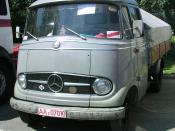Mercedes Benz Porter's 5 forces framework
Abstract
The intensity of competition in an industry is neither a matter of coincidence nor bad luck. Rather, competition in an industry is ill rooted in its underlying economic structure and goes well beyond the behavior of current competitors. The state of competition in an industry depends on five basic competitive forces i.e. entry, threat of substitution, bargaining power of buyers, bargaining power of suppliers, and rivalry among current competitors. (Porter, 1980) Daimler Chrysler's strategy rests on four pillars: global presence, strong brands, broad product range, and technology leadership. The objective of this analysis is to investigate how the organization needs to form its strategy in order to develop opportunities and protect itself against competition and other threats.
Company Introduction
Mercedes Benz is firmly established as an independent brand within one of the world's leading car companies- DaimlerChrysler AG. DaimlerChrysler is a product of Daimler and Chrysler companies.
Daimler motor company however came into existence as a result of the creation of a recognized internal combustion vehicle by Gottlieb Daimler. Daimler Chrysler's strategy rests on four pillars: global presence, strong brands, broad product range, and technology leadership-Daimler being the first man to create a recognized internal combustion vehicle and the first to incorporate a practical transmission system. The company has a super network that ensures the flow and exchange of information from various departments within and between the company and it's strategic partners.
Competitive Forces
The strength of the competitive forces in an industry determines the degree to which this inflow of investment occurs and drives the return to the free market level, and thus the ability of firms to sustain above-average returns The five competitive forces-entry, threat of substitution, bargaining power of buyers, bargaining power of suppliers, and rivalry among current competitors-reflect...


